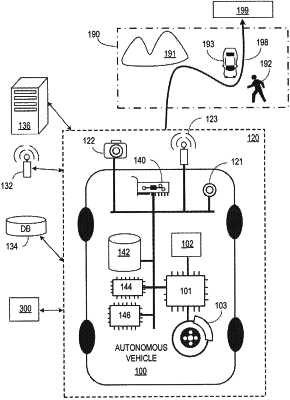| CPC G05D 1/0221 (2013.01) [G05D 1/0088 (2013.01); G05D 1/0214 (2013.01); G08G 1/16 (2013.01); G01S 17/931 (2020.01); G05D 2201/0213 (2013.01)] | 20 Claims |

|
1. A method comprising:
storing, using one or more processors of an autonomous vehicle located within an environment, a plurality of constraints for operating the autonomous vehicle within the environment;
receiving, using one or more sensors of the autonomous vehicle, sensor data describing the environment;
receiving, using one or more additional sensors of the autonomous vehicle, additional sensor data describing one or more physical characteristics of a passenger of the autonomous vehicle other than a driver of the autonomous vehicle; and
extracting, using the one or more processors, a feature vector from the stored plurality of constraints, the received sensor data, and the received additional sensor data, wherein the feature vector comprises:
a first feature describing an object located within the environment,
a second feature describing the one or more physical characteristics of the passenger of the autonomous vehicle,
a third feature describing a current operation of the vehicle;
determining, using the one or more processors, a hierarchical ranking of the stored plurality of constraints based on the feature vector, including the first feature, the second feature, and the third feature, wherein a rank of each constraint of the stored plurality of constraints corresponds to a level of navigational safety of the autonomous vehicle;
generating, using the one or more processors, a first motion segment based on (i) the feature vector including the first feature, the second feature, and the third feature and (ii) the hierarchical ranking of the stored plurality of constraints, such that a number of violations of the stored plurality of constraints is below a threshold, wherein the generated first motion segment comprises at least one of:
a trajectory between two spatiotemporal locations of the environment, or
a speed of the autonomous vehicle to avoid a collision of the autonomous vehicle with the object; and
causing, using the one or more processors, the autonomous vehicle to autonomously traverse to a destination in accordance with the generated first motion segment.
|